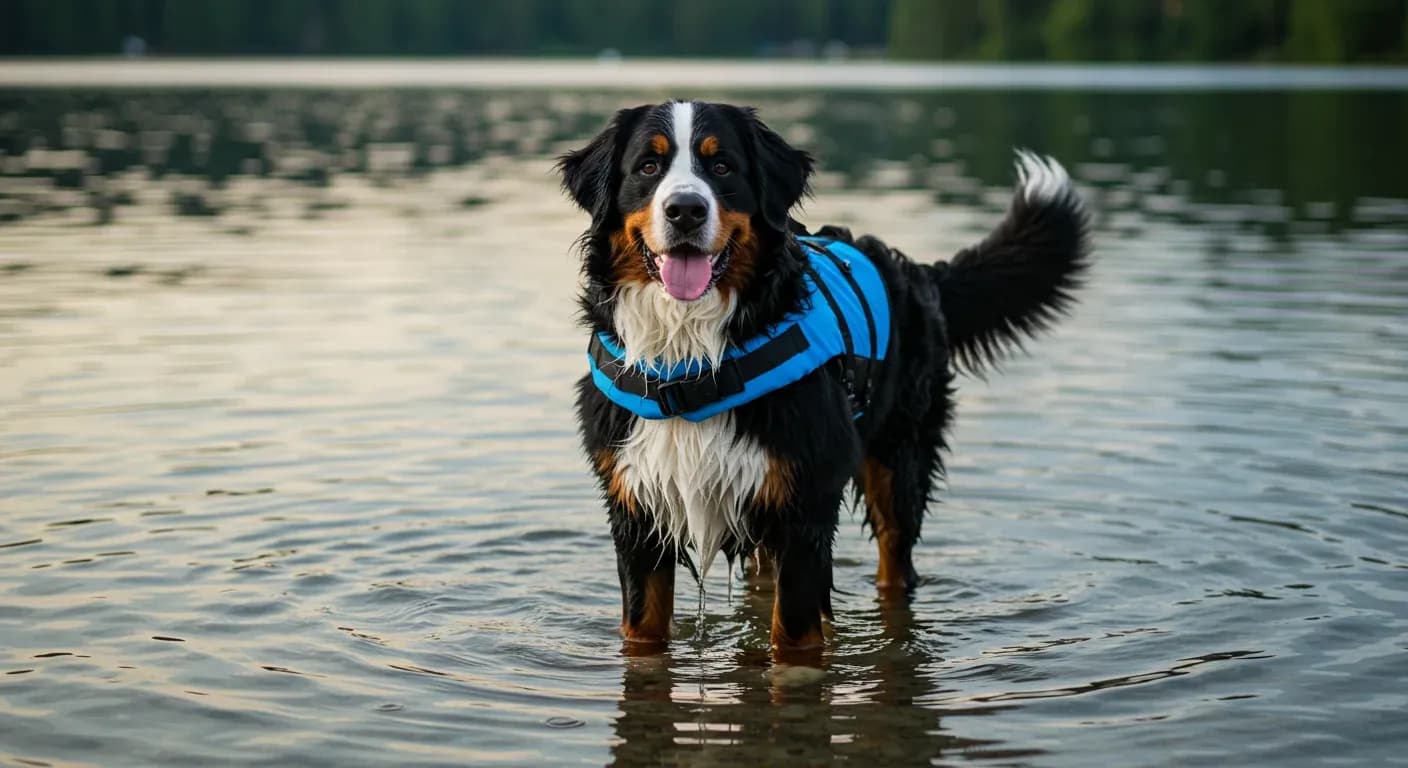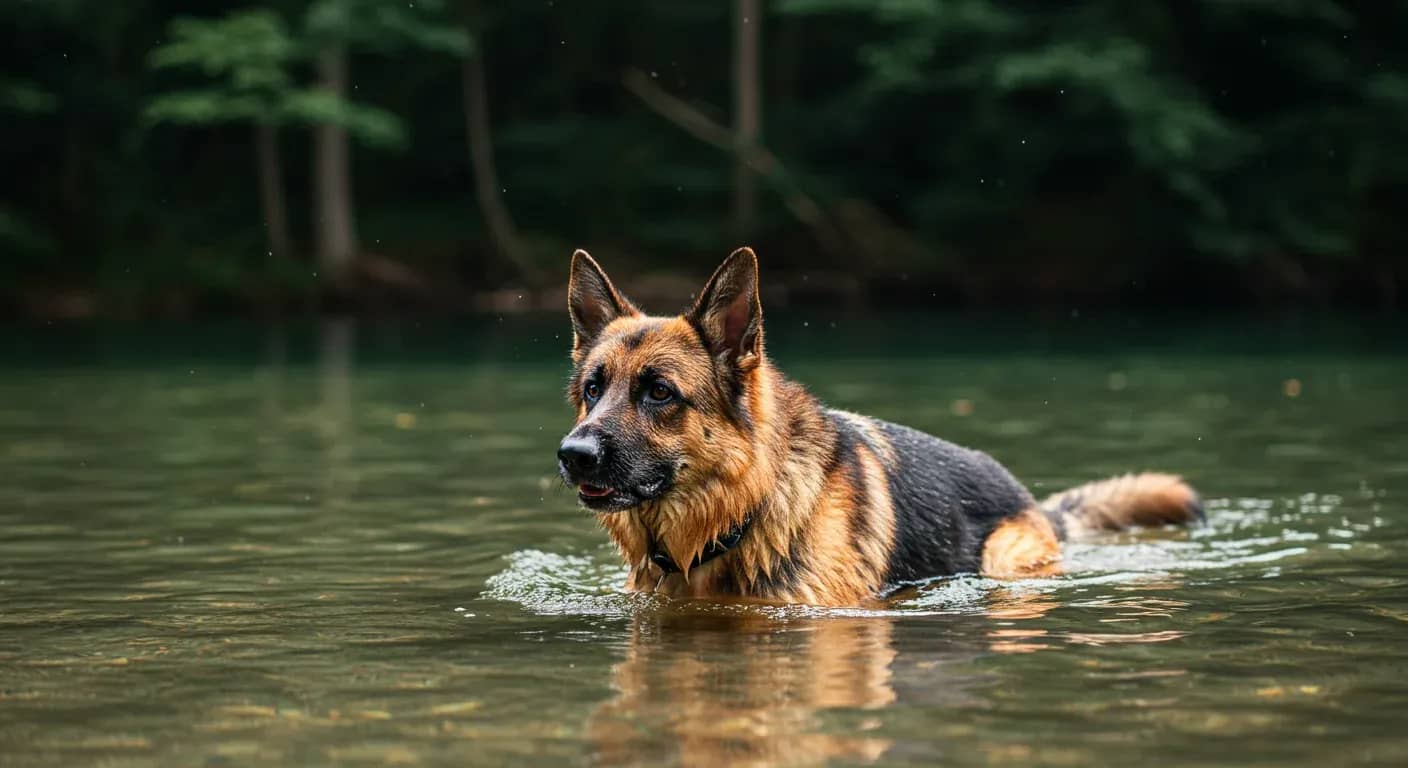At a glance
- Bernese Mountain Dogs aren't natural swimmers due to their heavy build and thick coat, but can learn with proper training
- Always use a canine life vest during training and swimming sessions for safety and confidence
- Start with shallow water and gradual introduction, keeping initial sessions to 5-10 minutes
- Swimming provides excellent low-impact exercise for this breed prone to joint issues
You might notice your Bernese Mountain Dog eyeing the water with curiosity but hesitation. Unlike breeds bred for water work, these gentle giants weren't designed for swimming. Their thick double coat and substantial build present unique challenges, but with patience and the right approach, many Berners can learn to enjoy the water safely.
Swimming offers remarkable benefits for this breed. The low-impact nature makes it ideal for dogs prone to hip and elbow dysplasia, while helping manage weight, a crucial factor in their longevity. Their thick coat also makes them susceptible to overheating, and swimming provides an excellent way to cool down during warmer months.
Understanding your dog's physical challenges
When it comes to swimming training in Bernese Mountain Dogs, their physical traits require special consideration. Their heavy, muscular build can make initial swimming attempts more challenging than with lighter breeds. That thick double coat, while water-resistant, becomes heavy when wet and increases fatigue during swimming sessions.
These dogs also have proportionally shorter legs compared to natural swimming breeds, which affects their efficiency in water. However, their eager-to-please temperament works in your favour. Most Berners respond well to positive reinforcement, though they can be sensitive to new experiences and may need extra encouragement around water.
Research shows that dogs with this body type benefit most from gradual introduction methods. The key is working with their natural caution rather than against it.
Setting up for success

Choose your training location carefully. Start in shallow, calm water such as a kiddie pool, the shallow end of a lake, or a pool with gradual entry. Avoid areas with strong currents, sharp objects, or slippery surfaces that could create negative associations.
A canine flotation vest is essential, not optional, for Bernese Mountain Dog swim training. Recommended brands include the Outward Hound Granby Splash, Ruffwear Float Coat, and EzyDog Summit Float, typically costing between $30-70. The vest should fit snugly, cover the chest and belly, and include a handle for easy lifting.
Plan sessions during cooler parts of the day. These dogs overheat easily, and combining their thick coat with physical exertion requires careful timing.
The gradual introduction method

Allow your dog to approach water at their own pace. Never force them in, as this can create lasting fear. Start by letting them explore and sniff the water, rewarding any positive interaction with treats and praise.
Encourage them to stand in very shallow water, just enough to wet their feet. Many dogs need several sessions just to become comfortable with this step. Use high-value treats and enthusiastic praise for any progress, even if it's simply standing near the water.
Enter the water with your dog to provide reassurance. Your presence often gives hesitant dogs the confidence they need to take the next step. Stay close and offer gentle encouragement without pulling or forcing movement.
Building swimming confidence
Keep initial sessions brief, around 5-10 minutes, to prevent fatigue. As your dog becomes more comfortable, you can gradually increase both depth and duration. The progression should feel natural and stress-free.
Use floating toys or treats to encourage forward movement in the water. Toss them just slightly ahead of your dog to motivate gentle paddling motions. Some dogs respond well to having a confident, water-loving dog demonstrate first.
Watch for signs of stress including excessive panting, trembling, or reluctance to enter the water. If you notice these signs, return to shallower water or take a break. The goal is building positive associations, not pushing through fear.
Safety considerations and monitoring
Never leave your dog unattended near water, regardless of their swimming ability. Even confident swimmers should wear life vests, especially in open water situations. Avoid cold water entirely, as these dogs aren't well-suited to low temperatures.
After each swimming session, rinse your dog thoroughly to remove chlorine, salt, or debris that could irritate their skin. Their double coat retains moisture easily, so dry them completely to prevent skin issues or bacterial growth.
Monitor for signs of joint discomfort during or after swimming. While swimming is generally beneficial for dogs with hip and elbow dysplasia, any signs of pain or stiffness warrant a veterinary consultation.
Troubleshooting common challenges
If your dog shows persistent fear of water, slow down the process even further. Some dogs benefit from group swim classes where they can observe other confident dogs. Professional trainers experienced with reluctant swimmers can provide valuable guidance.
Fatigue and overheating are common concerns with this breed. Provide plenty of breaks, ensure your dog stays well-hydrated, and consider shorter, more frequent sessions rather than longer ones. Signs of overheating include excessive drooling, rapid breathing, or seeming disoriented.
Some dogs remain reluctant to enter water despite patient training. This isn't failure, it's simply recognising your individual dog's preferences. Not every dog needs to swim, and forcing the issue can damage your relationship and create anxiety.
When to seek professional help
Consider consulting a professional dog trainer or behaviourist if your dog shows persistent anxiety around water or if you're unsure about training techniques. Signs that warrant veterinary attention include excessive distress, joint pain during or after swimming, or skin irritation that doesn't resolve with proper rinsing and drying.
Swimming can become a wonderful, beneficial activity for many Bernese Mountain Dogs when introduced thoughtfully. The key lies in respecting their individual pace, prioritising safety, and maintaining realistic expectations. With patience and proper technique, you might discover your gentle giant has a hidden love for the water.



